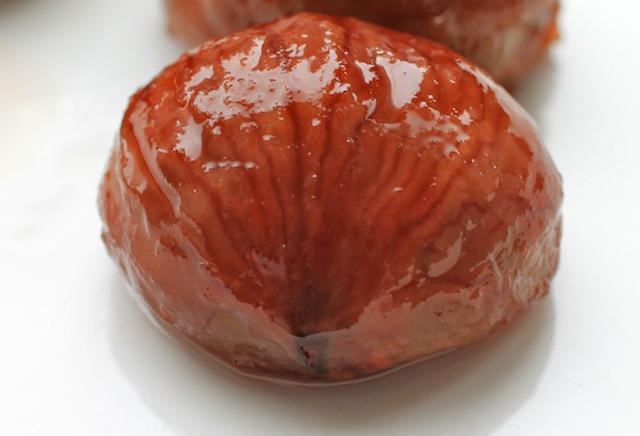
Did you know that the U.S. lost all its chestnut trees back in early 1900s due to a disease brought over from China or Japan? Oops. Almost all of the chestnuts we have now come from Italy or China. But
The American Chestnut Foundation has been working very hard to revive them in this country. Apparently small batches are starting to be available in local markets.
Chestnuts are hard work. You may not know if you haven't seen the entire chestnut in its thorny shells. They are so spiky and it really takes a lot of effort to get to the fruit. And it doesn't stop there. Chestnuts shells are bitch to peel, plus they have two layers: first the thick shell, then the inner, softer skin. Why is it so hard to reach the fruit? Because they are so good, you must work for them.
Since it takes great effort to prepare chestnuts, let's not just roast them. This is a recipe that requires patience, ideal in honoring chestnuts for all its stubborn-ness and delicacy. It's called
kuri no shibukawa ni (栗の渋皮煮), or chestnuts cooked in its own inner skin (sorry, the translation doesn't sound appetizing). This is different from Yoko's recipe for
kuri no kanroni, where the chestnuts are fully peeled.
Buying chestnuts is tricky. It's very difficult to tell how fresh they are, and most of the times, they are old and dry. The ones you get in Chinatown are hit or miss. However, I still like to use Chinese kind over Italian ones. Italian chestnuts are too skinny and way too brittle, so they break easily during cooking.
First, soak chestnuts in boiling water.
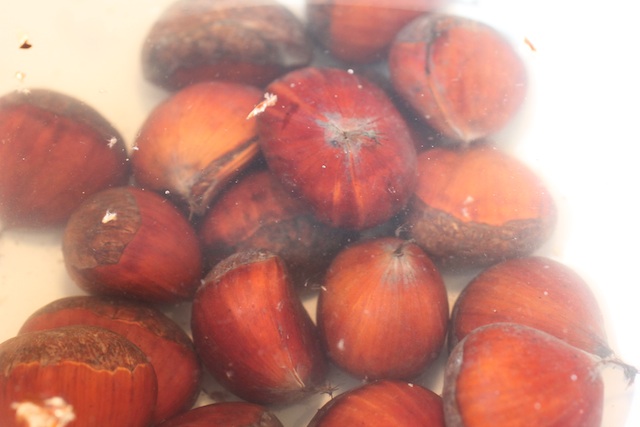
Then peel the outer shell once the hot water cools down enough. Don't wait until the water gets cold. The skin aren't as tough as you think. Try not to break the inner skin.

At this point, weigh the chestnuts and record it somewhere -- we will be using 70% of the weight of the chestnuts later. Put them in water, and add 1 tbsp of baking soda and boil.
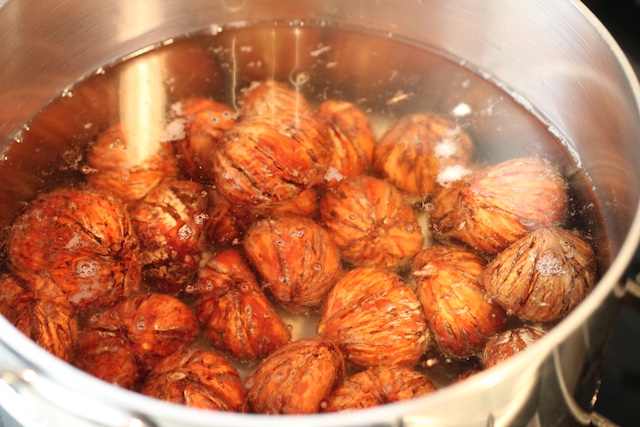
This is to get rid of the chestnuts' bitterness.
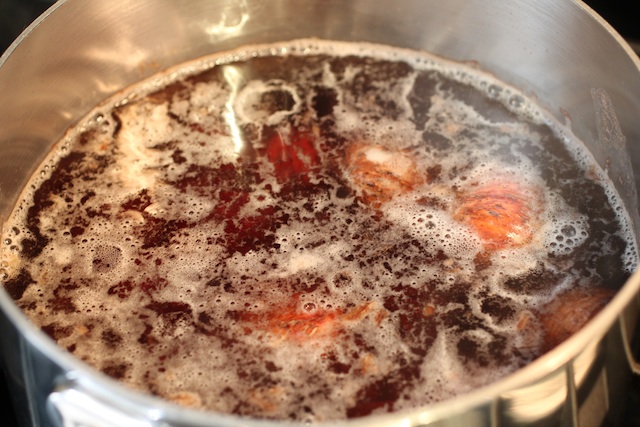
The water will get bloody red. Once it starts to boil, simmer for 10 minutes.
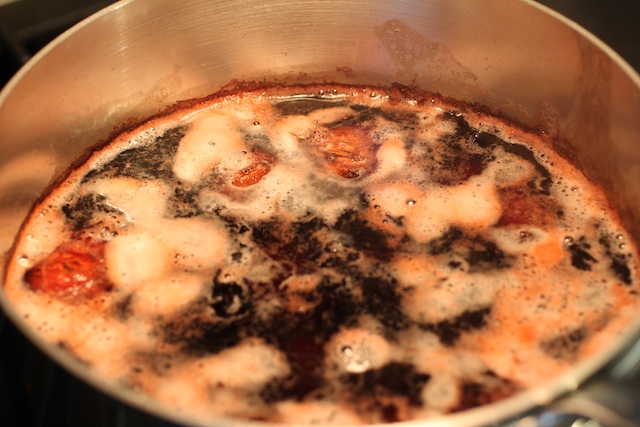
After that, rinse in cold water until the liquid becomes clear.
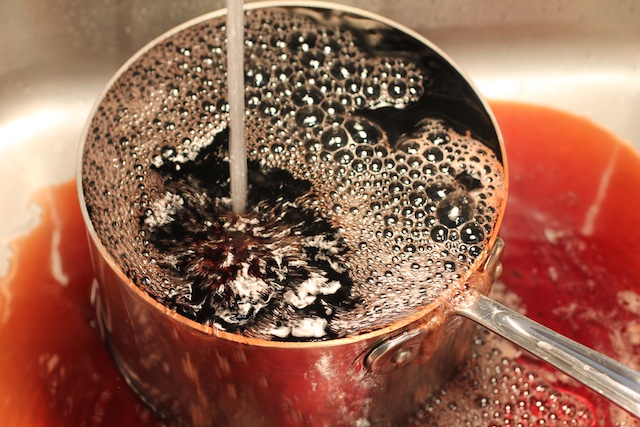
Repeat this process two more times, for a total of three times. Try to be very gentle when touching the chestnuts, and try to keep them in water the entire time.
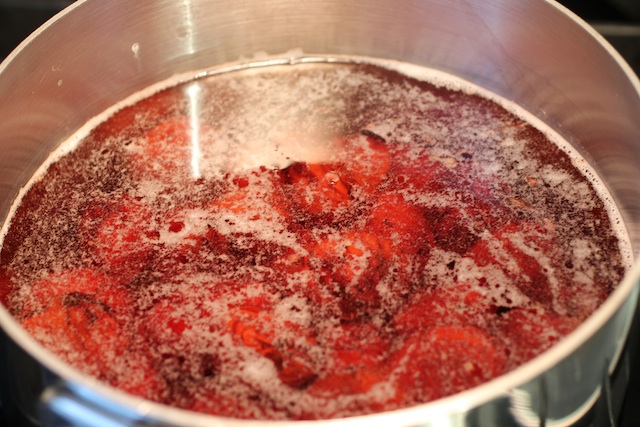
After the third round of boiling and rinsing, plus getting rid of all the crap on inner skin, they should look like these below.

After you rinse them in cold water, try to rub each chestnuts as if you were washing a baby's bottom. Ever so gently -- but you also want to get rid of all that crusty shit (literally). Be very careful not to tear the skin, just like when dealing with baby's bottom. By breaking the inner skin, you will end up breaking the whole chestnut, which we don't want. It tastes the same, but won't look as pretty as whole ones.
Add 70% of the weight of the chestnuts in sugar into the pot. Slowly heat this up.
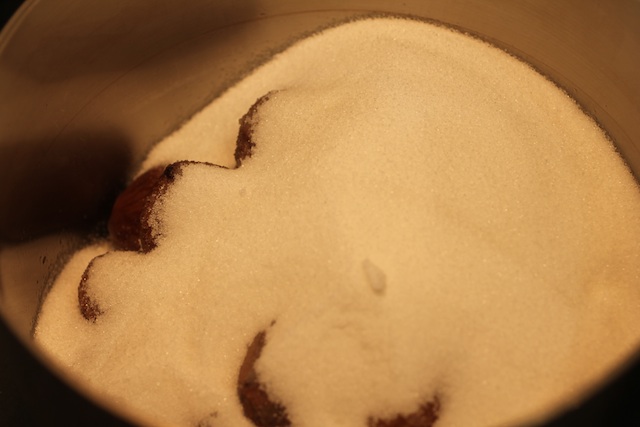
The sugar will melt pretty quickly. Stir to help it dissolve faster, but be very careful not to break chestnuts.

Once all the sugar melts, simmer for another 10-20 minutes. Once a toothpick goes through smoothly, it's done. You can add a dash of brandy here. Cool completely in the sugar syrup.
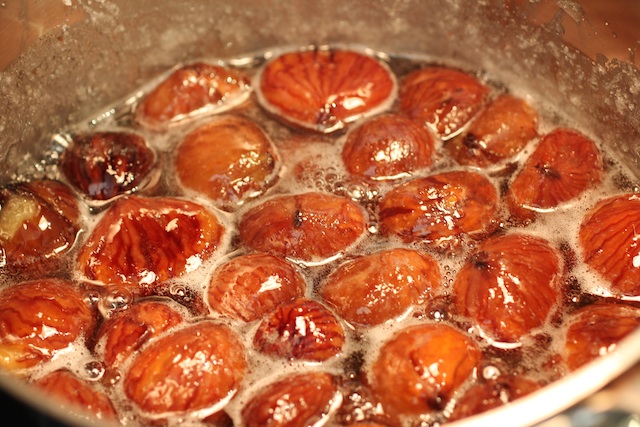
This is a pain in the ass, and because chestnuts are not that fresh in this country, 30% to half of them end up breaking into pieces, which is disappointing. But you can put the broken pieces into a food processor and make chestnut paste. So don't get discouraged by the failure rate, since they taste the same awesomeness.

I make bunch and wrap them individually and keep them in freezer. Eating them half frozen for a cold treat is also very nice.
 Did you know that the U.S. lost all its chestnut trees back in early 1900s due to a disease brought over from China or Japan? Oops. Almost all of the chestnuts we have now come from Italy or China. But The American Chestnut Foundation has been working very hard to revive them in this country. Apparently small batches are starting to be available in local markets.
Chestnuts are hard work. You may not know if you haven't seen the entire chestnut in its thorny shells. They are so spiky and it really takes a lot of effort to get to the fruit. And it doesn't stop there. Chestnuts shells are bitch to peel, plus they have two layers: first the thick shell, then the inner, softer skin. Why is it so hard to reach the fruit? Because they are so good, you must work for them.
Since it takes great effort to prepare chestnuts, let's not just roast them. This is a recipe that requires patience, ideal in honoring chestnuts for all its stubborn-ness and delicacy. It's called kuri no shibukawa ni (栗の渋皮煮), or chestnuts cooked in its own inner skin (sorry, the translation doesn't sound appetizing). This is different from Yoko's recipe for kuri no kanroni, where the chestnuts are fully peeled.
Buying chestnuts is tricky. It's very difficult to tell how fresh they are, and most of the times, they are old and dry. The ones you get in Chinatown are hit or miss. However, I still like to use Chinese kind over Italian ones. Italian chestnuts are too skinny and way too brittle, so they break easily during cooking.
First, soak chestnuts in boiling water.
Did you know that the U.S. lost all its chestnut trees back in early 1900s due to a disease brought over from China or Japan? Oops. Almost all of the chestnuts we have now come from Italy or China. But The American Chestnut Foundation has been working very hard to revive them in this country. Apparently small batches are starting to be available in local markets.
Chestnuts are hard work. You may not know if you haven't seen the entire chestnut in its thorny shells. They are so spiky and it really takes a lot of effort to get to the fruit. And it doesn't stop there. Chestnuts shells are bitch to peel, plus they have two layers: first the thick shell, then the inner, softer skin. Why is it so hard to reach the fruit? Because they are so good, you must work for them.
Since it takes great effort to prepare chestnuts, let's not just roast them. This is a recipe that requires patience, ideal in honoring chestnuts for all its stubborn-ness and delicacy. It's called kuri no shibukawa ni (栗の渋皮煮), or chestnuts cooked in its own inner skin (sorry, the translation doesn't sound appetizing). This is different from Yoko's recipe for kuri no kanroni, where the chestnuts are fully peeled.
Buying chestnuts is tricky. It's very difficult to tell how fresh they are, and most of the times, they are old and dry. The ones you get in Chinatown are hit or miss. However, I still like to use Chinese kind over Italian ones. Italian chestnuts are too skinny and way too brittle, so they break easily during cooking.
First, soak chestnuts in boiling water.
 Then peel the outer shell once the hot water cools down enough. Don't wait until the water gets cold. The skin aren't as tough as you think. Try not to break the inner skin.
Then peel the outer shell once the hot water cools down enough. Don't wait until the water gets cold. The skin aren't as tough as you think. Try not to break the inner skin.
 At this point, weigh the chestnuts and record it somewhere -- we will be using 70% of the weight of the chestnuts later. Put them in water, and add 1 tbsp of baking soda and boil.
At this point, weigh the chestnuts and record it somewhere -- we will be using 70% of the weight of the chestnuts later. Put them in water, and add 1 tbsp of baking soda and boil.
 This is to get rid of the chestnuts' bitterness.
This is to get rid of the chestnuts' bitterness.
 The water will get bloody red. Once it starts to boil, simmer for 10 minutes.
The water will get bloody red. Once it starts to boil, simmer for 10 minutes.
 After that, rinse in cold water until the liquid becomes clear.
After that, rinse in cold water until the liquid becomes clear.
 Repeat this process two more times, for a total of three times. Try to be very gentle when touching the chestnuts, and try to keep them in water the entire time.
Repeat this process two more times, for a total of three times. Try to be very gentle when touching the chestnuts, and try to keep them in water the entire time.
 After the third round of boiling and rinsing, plus getting rid of all the crap on inner skin, they should look like these below.
After the third round of boiling and rinsing, plus getting rid of all the crap on inner skin, they should look like these below.
 After you rinse them in cold water, try to rub each chestnuts as if you were washing a baby's bottom. Ever so gently -- but you also want to get rid of all that crusty shit (literally). Be very careful not to tear the skin, just like when dealing with baby's bottom. By breaking the inner skin, you will end up breaking the whole chestnut, which we don't want. It tastes the same, but won't look as pretty as whole ones.
Add 70% of the weight of the chestnuts in sugar into the pot. Slowly heat this up.
After you rinse them in cold water, try to rub each chestnuts as if you were washing a baby's bottom. Ever so gently -- but you also want to get rid of all that crusty shit (literally). Be very careful not to tear the skin, just like when dealing with baby's bottom. By breaking the inner skin, you will end up breaking the whole chestnut, which we don't want. It tastes the same, but won't look as pretty as whole ones.
Add 70% of the weight of the chestnuts in sugar into the pot. Slowly heat this up.
 The sugar will melt pretty quickly. Stir to help it dissolve faster, but be very careful not to break chestnuts.
The sugar will melt pretty quickly. Stir to help it dissolve faster, but be very careful not to break chestnuts.
 Once all the sugar melts, simmer for another 10-20 minutes. Once a toothpick goes through smoothly, it's done. You can add a dash of brandy here. Cool completely in the sugar syrup.
Once all the sugar melts, simmer for another 10-20 minutes. Once a toothpick goes through smoothly, it's done. You can add a dash of brandy here. Cool completely in the sugar syrup.
 This is a pain in the ass, and because chestnuts are not that fresh in this country, 30% to half of them end up breaking into pieces, which is disappointing. But you can put the broken pieces into a food processor and make chestnut paste. So don't get discouraged by the failure rate, since they taste the same awesomeness.
This is a pain in the ass, and because chestnuts are not that fresh in this country, 30% to half of them end up breaking into pieces, which is disappointing. But you can put the broken pieces into a food processor and make chestnut paste. So don't get discouraged by the failure rate, since they taste the same awesomeness.
 I make bunch and wrap them individually and keep them in freezer. Eating them half frozen for a cold treat is also very nice.
I make bunch and wrap them individually and keep them in freezer. Eating them half frozen for a cold treat is also very nice.



Comments (1)
Wow, these are beautiful Moto! Bravo.